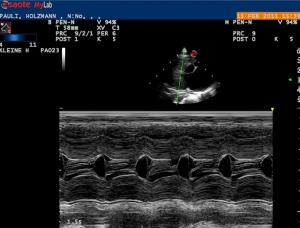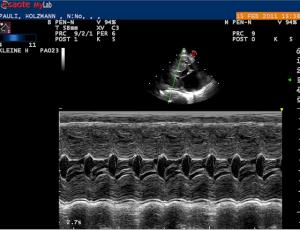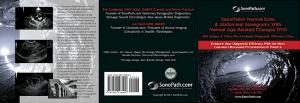SAM I AM…. No, this is not Green Eggs & Ham and Drs. Modler & Lindquist are not Dr. Seuss but have surely read tons of Seuss to their kids. At times a story that creates a visual in one’s mind helps the diagnostician identify with the pathology. Peter & Eric tell a story about a significant morphological defect, systolic anterior motion (SAM), mainly found in some cats that have hypertrophic cardiomyopathy.
This month Drs. Peter Modler & Eric Lindquist discuss SAM in cats and the latest on how to approach it clinically and sonographically in our December 2011 case of the month.
Have you ever wondered what may be causing that exercise intolerance in that cat chasing the ball across the room and suddenly stops, and starts open mouth breathing, and then may go back to normal activity? That cat may be SAM I AM:) Think of the cats with HCM you see in your clinical practice every day: Some have a loud heart murmur but don´t show any symptoms or maybe no murmur at all. Some may already be in CHF but don´t have a heart murmur. We all know that the loudness of a heart murmur does not correlate with the severity of the heart disease. And to illustrate the pathophysiology I would use the following visuals form Peter & Eric:
- Peter: Imagine the opening of a new supermarket in town. To attract people, they offer ice cream for free at the first day. So masses of people want run to that place and want to pass the small door to get the ice cream. The staff at the market want to close the door because they cannot cope any more with that many people. But as they do so the people start running faster to get through that door and start screaming. That´s what Peter imagines when he scans a cat with SAM.
- Eric: Imagine watching a funny car race the quarter mile and then it pops its parachute to stop it in high speed before it runs into the hay bales. This is the image that I see when I echo a SAM cat where the anterior mitral leaflet doesn’t get out of the way during left ventricular systole and creates a type of parachute effect on the blood ejected through the left ventricular outflow. This trapped blood flow resultantly gets often redirected back into the left ventricle and may manifest enhance backflows into the mitral apparatus and left atrium, which, in turn, may cause left atrial enlargement; but not always or consistent as many SAM/HCM cases do not have left atrial enlargement. Fixed LVOT obstruction with septal impingement on the LVOT works similarly but is more like someone continually stepping on a water hose and the plants don’t get watered as well….i.e peripheral circulation impairment.
The more technical explanation of Systolic Anterior Motion (SAM) of the mitral valve is caused by the combination of an abnormal architecture of the mitral valve apparatus (particularly the papillary muscles) and the Venturi effect; reduction in fluid pressure that results when a fluid flows through a constricted section of pipe. The changed mitral valve apparatus pulls the anterior leaflet into the LVOT, the Venturi effect then increases the stenosis proportionally to the outflow velocity making it a dynamic obstruction. This results in a late-systolic flow acceleration.
SAM has been widely treated with Atenolol but the hemodynamic sequelae of SAM are still subject to discussion. A recent study showed that mortality in HCM patients with or without SAM is not significantly different. This is supported by the theoretical consideration that the flow acceleration due to SAM occurs in late systole, when the ventricular diameter is already reduced and the LV wall thickness is increased. Thus, dynamic obstruction due to SAM is unlikely to cause a significant increase in LV wall stress. There is currently no evidence for or against treatment of SAM using beta blockers, so it depends mainly on the clinicians preference. The image set below demonstrates “SAM I AM” in action:





Comments